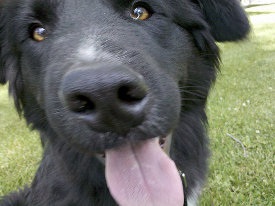|

Watching a dog go into convulsions and lose control is a scary thing. Seizures are common enough that it’s not unheard of in dogs, but not so common that most owners know how they happen and what to do. Why do dogs have seizures, what do they look like, and what should you do if your dog shows symptoms of one?
Why dogs have seizures
At the most basic level, seizures are caused by unusual electrical activity in the brain. Electrical activity in the brain is a fact of life and happens constantly. It’s when those electrical impulses go awry that problems occur.
Abnormal electrical activity may be caused by:
• Head injuries
• Improper liver, kidney, or thyroid function
• Toxins, such as rat poison, chocolate, and other substances dogs shouldn’t eat
• Viral infections, such as rabies
• Low blood sugar (hypoglycemia)
• Heat stroke
• Brain tumors
Those are just a few of many causes. Brain activity is a sensitive thing that can be thrown off by malfunctions in many other parts of the body’s systems. Anything from a knock on the head to chemical imbalances to organ failure can cause seizures.
What does a dog seizure look like?
There are 2 kinds of seizures. In a full grand mal seizure, the dog may first change behaviorally before the seizure hits. The dog may become restless, need attention, or hide. The seizure itself will lead to the dog’s muscles stiffening, possibly leading to a fall, muscle twitching, loss of consciousness, drooling, and loss of bodily functions. In a partial seizure, the dog will have twitching localized to a specific part of the body.
What should you do if your dog has a seizure?
If your dog looks like he’s having a seizure, take the following steps:
1. Stay calm.
2. Make sure your dog is not in a place where he may get injured.
3. Call your vet. (It’s helpful to program your regular vet’s phone number, as well as the nearest emergency overnight vet, into your cell phone so it’s handy.) They will tell you if it’s truly a seizure and what to do to between when the seizure hits and when you walk into the vet’s office.
4. Stay away from his mouth to avoid accidentally getting bitten.
5. Pay close attention to what is happening, including duration of the seizure. Take a video if you can. This will help you give your vet as much accurate information as possible to help them determine causes and treatments.
Dogs have seizures for any number of reasons. Keep your dog away from toxic substances and know the symptoms of a seizure. That way, if you see a dog having one, you’ll recognize it and be able to respond quickly.
For more practical info on dog health, sign up for Big Dog Blog updates. Enter your name and email in the green box at right.
If you liked this, you may also like:
Canine Heat Stroke: How To Recognize And Avoid It - Great to know in any climate, especially since it causes seizures
Why Do Dogs Eat Grass - If your dog eats grass on walks, he is at risk for ingesting pesticides used on lawns. Here's why and what to do.
Dog Muzzles That Allow Drinking - Keep your dog from eating things he shouldn't in the most comfortable, humane way possible
Photo credit: Katie Brady
|